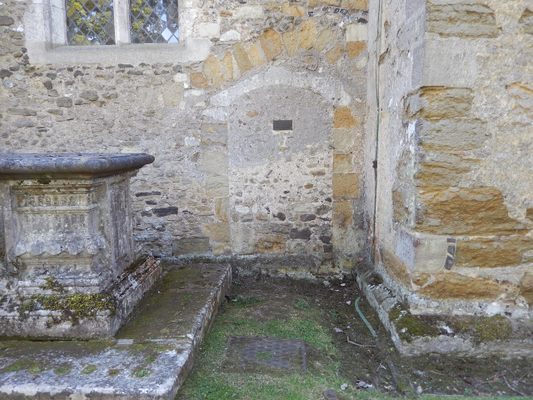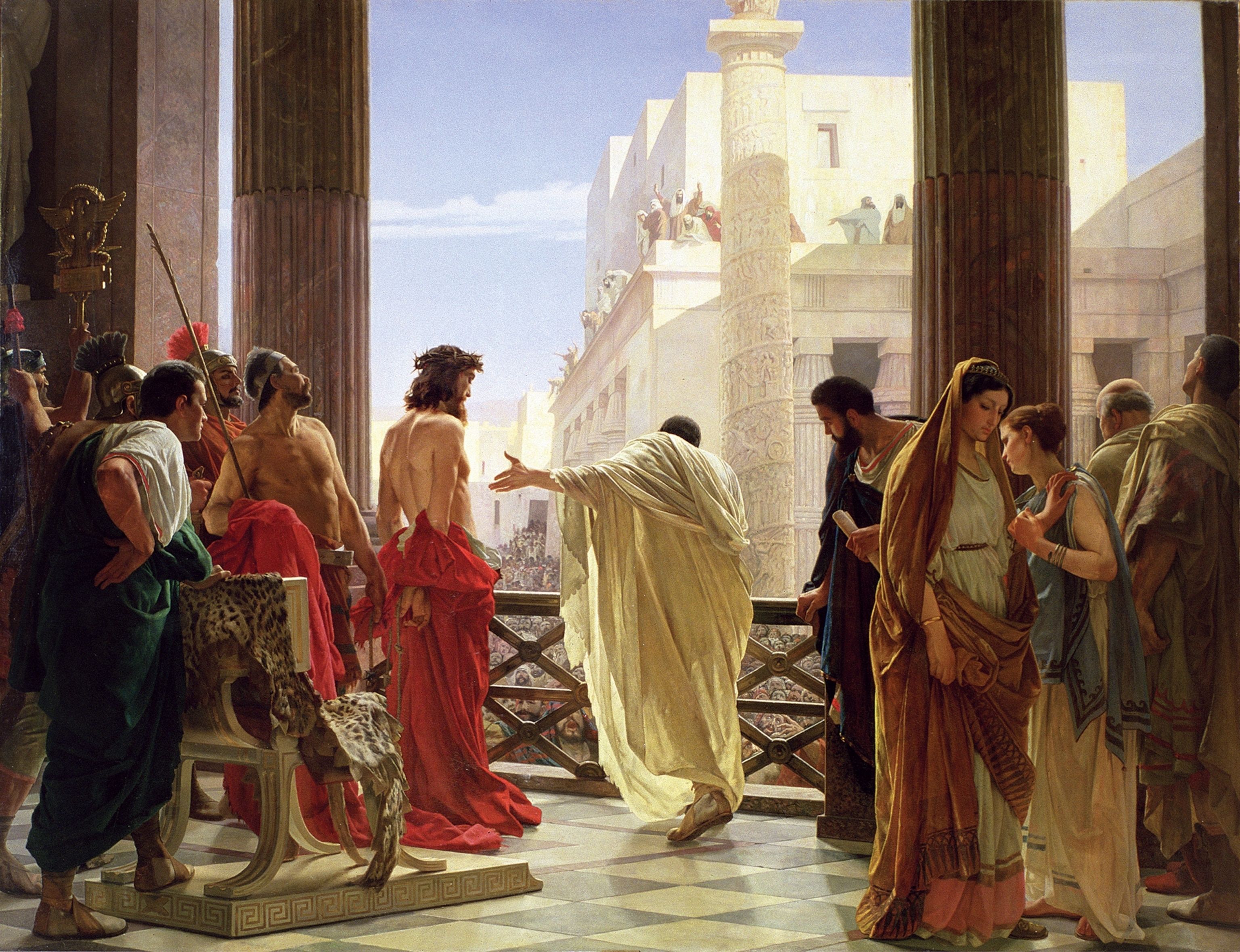* * * *

* * * *
September 6, 2025 – It’s been over a month since I last posted. That last post talked about the next big feast day, the Transfiguration of Jesus on August 6. It also noted that very morning I would be arriving in London. There I’d meet up with my brother and his wife, and from there hike the Canterbury Trail – what locals call the Pilgrims’ Way – 134 miles from Winchester.
I’m happy to say we finished the 16-day pilgrimage on Wednesday, August 27. (I took the picture above the next day, August 28, after some late-afternoon settling in, showering, a celebratory beer or two – and later doing two days’ laundry.) On that day of rest – Thursday, August 28 – we toured the Cathedral – free – after getting our final stamp. In my case, Canterbury was the last of 18 stamps in my book, starting with Winchester Cathedral on August 11.
There’s a fuller list of visited churches in the Notes, but I should also note that during that long-distance hike two August feast days came by: St Mary, the Virgin, on the 15th and St Bartholomew, Apostle on August 25. (“Transferred.”) So for now I’ll catch up on those special church days and – time and space permitting – add a tidbit or two about the hike itself.
First off, see Liturgical Home: St. Mary the Virgin: “On August 15th, Christians worldwide celebrate the Feast of St. Mary the Virgin, Mother of Our Lord, honoring the remarkable life of the mother of our Savior, Jesus Christ. It is a joyous occasion filled with reverence, thanksgiving, and reflection on Mary’s profound role in the salvation story.” It then notes “Mary’s Fiat,” her humble response to the astounding news that she would give birth to the Son of God:
The term fiat comes from the Latin word for “let it be” or “so be it.” Mary’s fiat is a profound act of faith, obedience, and surrender to God’s will. Her acceptance of God’s plan without hesitation has made her a model of faith for many Christians and is a central theme in Christian theology and devotion. Her “yes” to God’s plan contrasts with Eve’s disobedience, making Mary’s “fiat” a critical moment in salvation history. (Emphasis added.)
Thus the traditional view. But see also Annunciation (2022) – and Mary “shrinking back.”
That post noted what Garry Wills said about how Mary may have reacted to the good news: “For me, the most convincing pictures or sculptures of the Annunciation to Mary show her in a state of panic … shrinking off from the angel, looking cornered by him.” He noted especially some 14th century paintings showing Mary “so faint by the angel’s words that she sways back and must grab a pillar to keep herself upright.” (On that note see also Luke 1:29, with some translations showing Mary “deeply troubled,” or in other translations “confused and disturbed,” or agitated, perplexed or alarmed. See also her look – “almost of horror at what she has just been told” – as shown in Dante Gabriel Rossetti‘s 1850 painting.)
But whether you think she reacted without hesitation or in a state of panic at what God planned, Mary’s place in Christian history is secure. Mary (mother of Jesus) – Wikipedia:
Christians hold her son Jesus to be Christ (i.e., the messiah) and God the Son Incarnate. Mary (Maryam) also has a revered position in Islam, where a whole chapter of the Qur’an is devoted to her, also describing the birth of Jesus… [She] is considered by millions to be the most meritorious saint of the Church. Christians of the Catholic Church[,] Anglican Communion, and Lutheran churches believe that Mary, as Mother of Jesus, is the Mother of God and the Theotokos, literally “Bearer of God.”
Turning to St. Bartholomew and his feast day, he is mostly famous for being flayed alive, and for the massacre that came on his feast day in 1572, during the French Wars of Religion:
The St. Bartholomew’s Day massacre … was a targeted group of assassinations and a wave of Catholic mob violence, directed against the Huguenots… Though by no means unique, it “was the worst of the century’s religious massacres.” Throughout Europe, it “printed on Protestant minds the indelible conviction that Catholicism was a bloody and treacherous religion.”
Unfortunately we don’t know much about Bartholomew, but many scholars identify him with Nathaniel. See John 1:45-51: “Philip found Nathanael and told him, ‘We have found the one Moses wrote about… Jesus of Nazareth.’” And so St. Bart is generally identified as the Nathanael Jesus saw – in the first chapter of the John’s Gospel – sitting under the fig tree.
So much for the two feast days I missed in August. Now for a tidbit from the hike, in this case involving our visit to St. James’s Church in Shere on August 17. Here’s what I wrote about the “creepy hole in the wall” that we found inside, as explained by a local lady:
It seems one Christine Carpenter wanted to be an Anchorite, dedicating her life to Jesus, by staying in this cubby hole in the wall of the church. The clover-shaped thing on the left was where she could receive communion. The other is where she could watch the church service. Then she changed her mind, but The People wouldn’t let her out. The church lady who related the story said nobody knows whatever happened to poor Christine, who wasn’t allowed to change her mind after that…
Which definitely piqued my interest. For example, I checked Wikipedia, which said that by initially leaving her cell Christina violated her Anchorite vows and so was in danger of excommunication. She changed her mind again, but to make sure she didn’t change a third time, when readmitted to the cell her doorway was walled up. (Shown in the image below.)
That church visit definitely creeped me out – shades of the Cask of Amontillado – but it made me think. Did Mary feel “walled in” by the course set out for her? Did she ever try to change her mind? Did she ever want out, metaphorically or otherwise? Did she struggle with her fate, as Jesus did on the cross? Which I suppose is a benefit of walking hour after hour, mile after mile on a long pilgrim hike. Sometimes you get so bored you end up thinking outside the box.
One thing for sure. Leaving Christina’s walled-in Anchorite cell at St. James’s in Shere, I reveled in my rediscovered freedom to “walk free and own no superior.”
* * * *

* * * *
The upper image is courtesy of… Myself. I took the picture the morning after we trudged into Canterbury from Chilham. (See Towns & Villages in Canterbury – Visit South East England, on the town where we spent out last night on the Trail: “Renowned for its beauty and charm, the Kentish village of Chilham lies high above the valley of the River Stour in the picturesque Kent Downs.”
The Book of Common Prayer reference: The “corporate-mystical” prayer is on page 339, the post-communion prayer for Holy Eucharist, Rite I.
Feast days are designated days on the liturgical (church) calendar “set aside to commemorate events, saints, or doctrines that are important in the life of the Church. These can range from Solemnities, which are the highest-ranking feast days like Easter and Christmas, to optional memorials that celebrate lesser-known saints.” Feast Days: Celebrating the Church’s Calendar.
The fuller list of churches with pilgrim stamps: St. Swithun’s Church Martyr Worthy, St. John’s Church Itchen Abbas, St. Peter’s Church Ropley, Holy Rood Holybourne, Guildford Cathedral, St. Katharine’s Merstham, St. Bart’s Otford, St. James Shere, St. Mary’s Church Thurnham, St. Mary’s Church Lenham, and St Mary Bredin, a half-mile southeast of the Cathedral, down Old Dover Road and across “Nunnery Fields” from Canterbury Launderette, the only one in town. (I.e., Thursday morning we did our two days worth of laundry first, then went to the Cathedral for the final stamp and tour.)
Re “Free.” Tickets into the Canterbury Cathedral normally cost about 18 British pounds.
St. Bartholomew “transferred.” His feast day is August 24, but because 8/24/25 came on a Sunday, it was transferred to the following Monday.
The link John 1:48 Commentary and Explanation – Explaining the Bible notes, “This interaction reveals the omniscience of Jesus, showcasing that He knows each one of us intimately, including our thoughts and our moments of solitude.”
For this post I borrowed from 2014’s St. Mary, Mother, 2019’s St. Mary, “Virgin,” and more on Jerusalem, St. Mary, 2020 – and “Walls of Separation,” and On St. Mary, Virgin – 2024. As for St. Bartholomew, 2017’s St. Bartholomew – and “his” Massacre, and Pilgrimage, doing penance and “St. Bart – 2024.”
See “Dante Gabriel Rossetti‘s 1850 painting” in the The Annunciation (2022) post.
The full link Walt Whitman: ‘Freedom – to walk free and own no superior discussed the two perspectives on freedom, external and internal.
The external perspective perceives freedom as the absence of external control or domination. It revolves around the idea of breaking free from societal norms, oppressive systems, and the constraints imposed by others. This concept aligns closely with Whitman’s quote, as seeking emancipation from any superior implies rejecting external influences. On the other hand, the internal perspective on freedom focuses on breaking free from the mental constructs and limitations that restrict personal growth. It involves self-reflection, introspection, and a journey towards self-discovery. (Emphasis added.)
Re: Jesus on the cross. See My God, my God, why hast Thou forsaken me? – Wikipedia.
The lower image is courtesy of Cell of the Anchoress of Shere – Atlas Obscura, which added: “Christine broke out of the anchorage after almost three years and attempted to rejoin society.” See also – aside from Wikipedia – Secret Surrey: The woman who chose to spend her life in a cell, The Anchoress of Shere, Christine Carpenter – Shere Delight, Cell of the Anchoress of Shere – Atlas Obscura, or Christine Carpenter – Surrey Cultural Lives. For more on Anchorites see Wikipedia: Such people were required “to take a vow of stability of place, opting for permanent enclosure in cells often attached to churches. Also unlike hermits, anchorites were subject to a religious rite of consecration that closely resembled the funeral rite.”
* * * *
















 That Garden Bistro included a “mini-bar” – a small bar within the complex itself – that served cocktails for those pilgrim’s at St. George’s who wanted a little something stronger to go along with their evening meal. The photo at left shows the courtyard where we usually had our evening meals.
That Garden Bistro included a “mini-bar” – a small bar within the complex itself – that served cocktails for those pilgrim’s at St. George’s who wanted a little something stronger to go along with their evening meal. The photo at left shows the courtyard where we usually had our evening meals.


